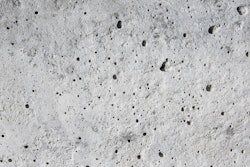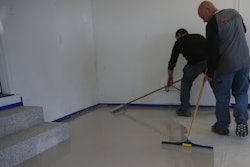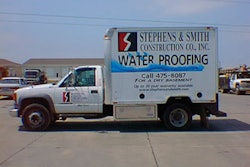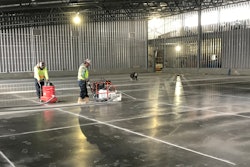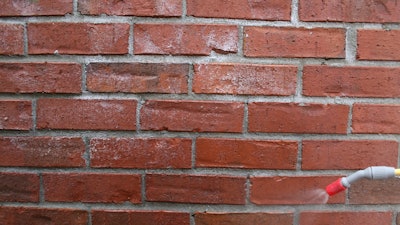
It can be quite frustrating when that white, chalky substance known as efflorescence or "new building bloom" shows up on your freshly poured surface. Luckily, efflorescence can be treated and removed, and prevented in the future.
The experts at Quikrete have shared with us the causes, treatments and prevention methods for efflorescence buildup.
What is Efflorescence and What Causes It?
Efflorescence is defined as the appearance of an unwanted, powdery substance on the surface of concrete or mortar. Usually this white or off-white discoloration to concrete and masonry forms when soluble salts and other water dispersible materials come to the surface through capillary voids as a result of temperature changes, moist migration, condensation, rain, dew, and/or too much water in the mix. It can happen quickly or over time, but either way, efflorescence can transform an otherwise attractive concrete or masonry surface into an unsightly eye sore on a building, home or other structures.
Any material containing portland cement is susceptible to efflorescence. It generally occurs when calcium hydroxide (lime) formed in cement hydration reaction is transported by water to the surface through capillaries in the concrete. There, it combines with carbon dioxide from the air to produce calcium carbonate and water. But efflorescence can also be caused by hydroxides and sulfates of either sodium or potassium, which are much more soluble in water than calcium. And they form efflorescence more rapidly than calcium hydroxide.
These salts can come from cement, aggregates, water or admixtures. The result in either case is a white discoloration that contrasts with the color of the concrete or masonry surface.
How Can Efflorescence be Avoided/Prevented?
It might be difficult to avoid efflorescence completely, but there are effective ways to prevent or minimize efflorescence formation by controlling the three contributing factors:
- Soluble salts
- Moisture
- Migrating channels
Concrete and mortar manufacturers can use high quality and clean ingredients, add pozzolans and other lime-consuming materials, incorporate water-repellent and other efflorescence controlling admixtures.
Contractors should use the proper amount of mixing water and proper curing techniques to lower the matrix porosity and water absorption of concrete. Quikrete Acrylic Cure and Seal is an prevention for efflorescence, since it can not only cure concrete and mortar more effectively but also form a sealing topical coating to prevent exterior moisture penetrating into concrete.
How Can Efflorescence be Removed?
Despite the best efforts to prevent efflorescence, it can still occur. While sandblasting is a traditional option for removing efflorescence, that process can etch damage and weaken concrete masonry surface. Specially-formulated, water-based chemical treatments like QUIKRETE Efflorescence and Rust Remover offer an easy, safe and effective alternative to sandblasting.
A solvent-free, low VOC product, QUIKRETE Efflorescence and Rust Remover can enhance concrete and masonry surfaces by eliminating efflorescence in just four steps.
Note: Always wear rubber gloves, eye protection and rubber boots when working with concrete and masonry cleaning products.
- Sweep and remove all soil and debris from the surface
- Dilute product in a plastic container to a 1:4 dilution. Brush or spray diluted material onto surfaces carefully. A more concentrated dilution is appropriate when necessary, but exercise caution to avoid etching the surface
- Allow the material to work for one minute
- For heavy efflorescence, scrubbing with a medium to stiff bristled nylon brush will improve removal. Rinse thoroughly with water
QUIKRETE Efflorescence & Rust Remover should be test applied in an inconspicuous spot to optimize the application technique and to evaluate the effect, before treating the entire area.
If There is Efflorescence on my Project, is it a Structural Problem or Cosmetic?
Most of efflorescence on concrete and mortar is only cosmetic.
Proper cleaning and then suitable prevention can usually supply satisfying results to owners.
In some very rare cases, some severe efflorescence is accompanied with scaling, deterioration and structural failure. It may indicate other durability issues and it takes may take time for engineers to figure out and fix these.
Will it Go Away with Time?
Usually efflorescence won’t go away totally with time by itself. But light efflorescence may fade or mingle with surroundings due to aging or weathering and there may be no need to treat or clean it.
Published with permission from Quikrete.




